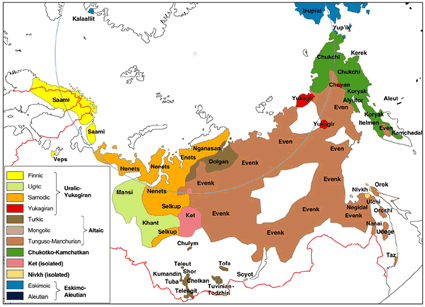The Kets are among the smallest people groups in northern Siberia. According to the 1989 census, there are 1,084 people. "Ket" means "the people who are free and live in the taiga." They have been known as the Kets since 1029's. Prior to 1029, they were known as Ostyaks, Yenisei Ostyaks, or Yeniseins. The Kets' ancestors were formed down south between the Ob and Yenisei Rivers as a result of mixture of Europeans from South Siberia and the ancient Mongolians.
The Kets have settled north of Krasnoyarsky Krai, with a majority of them located in the territory of Turukhansk District. They reside by compact groups along with Yenisei River tributaries (Yelogui, Surgutikha, Pakulekha, Kureika). Some of the Ket families live among Russians in other Yenisei River villages. During the first millennium AD, they came in contact with Turks, Samodi- and Ugro- speaking people. As a result of the migrations, smaller groups started settling on the north of Yenisei River. There are three kinsmen local groups known as Zemshaks on the Lower Podkamenaya Tunguska, Bogdences on Bakhta river, and Inbacks in the Yelogui River basin. Later on, because some families moved to the north, mixed territory groups were formed.
The Ket language is separated, and does not include or is not even similar to any other Asian language. The linguistic researchers of modern time have emphasized common features in the basic principles of the Ket language and some languages of Caucasus mountaineers—the Basks and North American Indians. The Ket language is divided into two different dialects: Imbatsk and Symsk which considerably differ from each other in phonetics, accidence, and vocabulary. Ket writing is built on the basis of Russian language graphics. Ket language school teaching was restored after the 1930s. Now they have compiled an ABC book and other textbooks in the Ket language.
In traditional culture, there is a combination of walking fishermen and taiga hunters with cultural elements such as the use of dugouts, food storage, fur coats, composed footwear, the Earth cult, animals, etc. For Southern Siberia and Central Asian nomadic people, common elements are their hut, tunic clothes, blacksmith trade, shamanism, etc. When trading, it is primarily fish, elk, and deer, water and forest birds. The use of deer transportation was adopted in the second part of the 17th-18th Centuries from the Samoyeds; however, it was not used amongst all of the Kets. All P. Tunguska groups lived without deer. Their food was boiled and roasted meat and fish. They would eat the stored up dried yukols, porses, fish fat, and dried meat. The food was cooked on a fire, while the unleavened bread was baked of flour in the fire ashes or in an over made of clay. During the summertime, their food would also consist of all kinds of berries, tubers of saran, and instead of tea, they brewed other plants.
At home, men worked with wood, bone, and as smithies. Ket bows, knifes, and scrapers, etc., were famous in the north Yenisei River area and were good to exchange. The women dressed in skins (of beasts, birds, and fishes), and birch bark. Utensils were also made with the same items. Underclothes and summer footwear were made out of deer leather. Winter footwear consisted of fur boots with cloth tops. While traveling on deer sleighs, they put on fur clothes with hoods and fur boots.
The Kets' traditional dwelling was a conic hut made of poles and birch bark covers. It also had a dugout with a framework of sloping logs. Their temporary shelters were holes in the snow, huts of bent branches, and other household constructions (such as deer sheds with flues and barns on piles). In the beginning of the 20th century, the first framework house appeared. They had been moving to the places where they would do summer fishing and in the fall they would move to hunting areas by huge boats (Ilimka) with a room covered with birch bark. There was a spread of one-piece boats. During the winter hunting they used hand and deer sleigh, trails of elk skin, and wide skis with the bottom covered in fur (kamus).
The Kets kept their traditional beliefs and cults that were formed on the basis of early mythological ideas about the world. The Kets are shamanistic people. They never had professional shamans though. The main function of shamans was to cure and predict. In the image of the High god Esi (sky god), they personified the sky and connected to it nature's phenomenon. The Mistress of the North opposed him and the bearer of evil, Khocedem, was believed to send troubles, curses, plagues, and sicknesses. The South Mistress, named Tomem, was personified in the image of migrant birds. They had a cult of fire, family guardian spirits, and spirit-masters. Also, they had Alels, the guardians of home and family who were pictured in the forms of female figures.
Pray for the modern Kets to have a heart hunger to know the One True God of all!
Pray for missionaries to come to them living lives that demonstrate God's message of love and forgiveness and to be able to find ways to present the Truth of God's Word in an understandable and compelling way.
Pray for God to help the Kets receive Jesus as their Savior and walk with Him as the Way, Truth and Life.
Scripture Prayers for the Ket, Yenisei Ostyak in Russia.
Harvest in the Snow: Pray for Siberian Indigenous Peoples http://harvestinthesnow.org/index.php?id=11,28,0,0,1,0
"Kets", The Red Book of Peoples, http://www.eki.ee/books/redbook/kets.shtml
"The Kets", http://russia.rin.ru/guides_e/4712.html
| Profile Source: Jubilee Adleta |











